1
Making butter is a relitively simple process, in theory. Many families used to make their own butter using a butter churn or simply vigorously shaking a jar of cream! However the process of producing high quality butter in large quantities as made by the Tatamagouche Creamery ,was a bit more complex.Average production of the Tatamagouche Creamery was around 600,000 pounds of butter a year, but in one peak year about one million pounds of 'the best butter in the world' was produced.
2
The Tatamagouche Creamery before the renovation in 194320th century
The Tatamagouche Creamery, Creamery Road, Tatamagouche, Nova Scotia, Canada
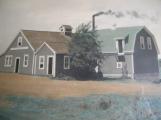 Credits:
Credits:Unknown
North Shore Archives
3
Cream for making butter was obtained from farms in the areas surrounding the Creamery from as far away as the communities of River John, Pugwash and Wentworth, Nova Scotia. The cream was shipped from the farms in 2 1/2, 4, 5, and 8 Imperial gallon cans which corresponded to 25, 40, 50 and 80 pounds of cream respectively. These cans were usually made at Crockett's in Westville, Pictou County, although some were made in Shubenacadie - 'The Cream Can Capital of the World"4
Cream can and milk can20th century
The Tatamagouche Creamery, Creamery Road, Tatamagouche, Nova Scotia, Canada
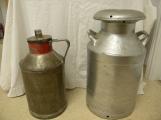 Credits:
Credits:Sunrise Trail Museum
North Shore Archives
Raymond Lewis
Tinsmith Museum Shubenacadie
5
On arrival at the Creamery, the cans filled with cream were unloaded and taken in to the weighing, testing and grading area to the left of the entrance. A sample of cream was taken and placed in six inch high glass bottles. The red number painted on the bottles is the cream can number, for easy identification. This number also refers to the specific farm the cream came from, with all cans of cream from a particular farm having the same number.6
Glass bottles used to store cream samples20th century
The Tatamagouche Creamery, Creamery Road, Tatamagouche, Nova Scotia, Canada
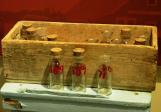 Credits:
Credits:Creamery exhibit, in Creamery Square Heritage Centre
7
During the month samples continued to be taken and added to the bottles which were stored on A-framed racks until they were sent in small wooden boxes to the Nova Scotia Agricultural College in Truro, Nova Scotia ,for check tests. In more recent times the test bottles were sent to Scotsburn for testing and eventually inspectors came to test at the Creamery. The cans of cream were weighed, recorded and tagged with the test results.8
The cream testing area inside the Creamery20th century
The Tatamagouche Creamery, Creamery Road, Tatamagouche, Nova Scotia, Canada
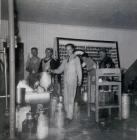 Credits:
Credits:North Shore Archives
9
Farmers were paid according to the butterfat content of their cream. The higher the fat content the more money the farmer received. The popular Jersey cow produced milk with about 5.5% butterfat and if a different breed of cow was kept, then it was common for some farmers to keep a number of Jerseys in the herd to boost the butterfat content. Prices received by the farmer for the butterfat content were worked out between J.J. Creighton and Mr. MacConnell of Scotsburn Co-op Ltd, the main competition, and later owners. Sometimes it was estimated that one business could afford to pay out more than the other, another month the reverse, but somehow between them a fair price was found.Testing the amount of butterfat was therefore a very important process at the Creamery. To begin testing, the cream was thoroughly mixed in the can using a metal stirring device. This stirred the cream as well as brought unwelcome additions to the surface - salamanders and snails (according to Mike Weatherby) and black flies (as Raymond Campbell remembers) were occasionally found, especially in the early days, presumably falling in from the well or cellar during the storage time on the farm.
10
Wes MacLennan in the testing room20th century
The Tatamagouche Creamery, Creamery Road, Tatamagouche, Nova Scotia, Canada
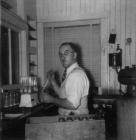 Credits:
Credits:North Shore Archives
11
Mike Weatherby, a former employee, remembers the testing process from his day, " . . . a sample of cream was put in a glass bottle with the farmer's number on it in red paint. This was shaken and a smaller quantity removed into a glass testing tube and carefully weighed to ensure all samples taken were the same weight. A measured amount of sulphuric acid was added, and then some warm water . . . the test tube was put in a small metal container and placed in a centrifuge for three minutes and then removed - it was very hot and care was necessary. The butterfat floated to the surface where it was carefully measured . . ." In Mike's day all testing was done at the Creamery, with the inspector coming regularly once a month to check their results. An accuracy to within 0.5% was satisfactory.During testing the cream was tasted using a long handled silver spoon to see if it was sweet or sour. When Mike was working in the Creamery from the late 1970's, he and some others were sent on a three day 'butter tasting' course at the Nova Scotia Agricultural College in Truro, Nova Scotia. Tasting was all important, however relying on the 'taste test' upset some farmers whose cream failed. They obviously thought 'tasting' was unreliable! If the cream was found to be sour then soda was added to the cream. If it was found to be sweet then that cream was often sent to ice cream manufacturers, such as Byers of Sydney. Farmers were paid a bonus for sweet cream.
12
Taste testing cream at the Creamery20th Century
The Tatamagouche Creamery, Creamery Road, Tatamagouche, Nova Scotia, Canada
 Credits:
Credits:David Butlin
13
The cream pasteurizer20th century
The Tatamagouche Creamery, Creamery Road, Tatamagouche, Nova Scotia, Canada
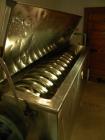 Credits:
Credits:Creamery Exhibit, Creamery Square Heritage Centre,